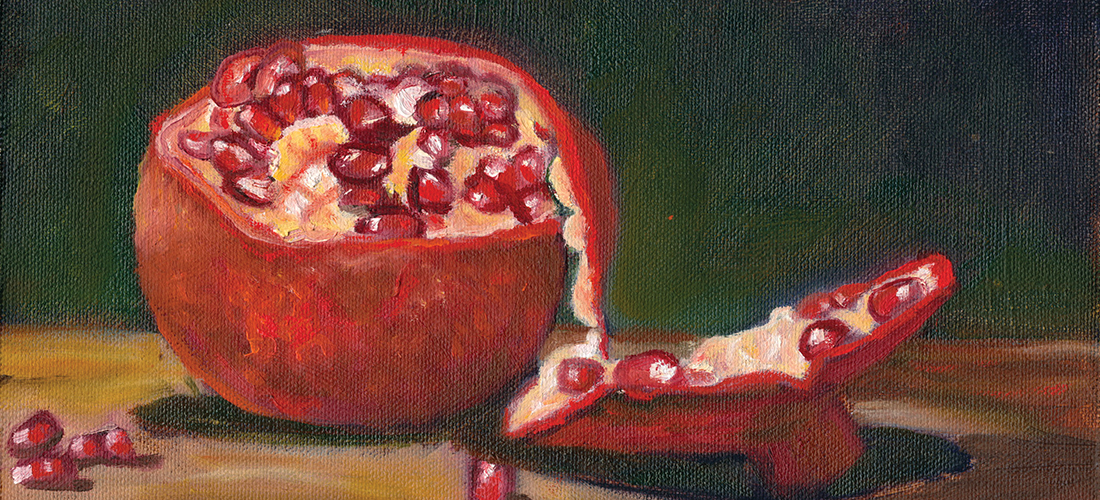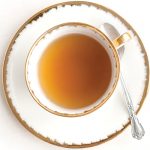
December pomegranates
By Jan Leitschuh
Ruby red
pomegranates are starting to appear in groceries now as a seasonal item. Their cheerful rosy husks evoke a sense of Yuletide feasting and decoration. Their origins are Mediterranean, and exotic.
Pomegranate fruits are actually berries, filled with hundreds of jewel-like seeds, usually dark red. The sweet, fleshy, juicy coating surrounding each seed, often referred to as the aril, is the edible portion.
Are you surprised to learn that these juicy, seedy delights are not only wildly healthy — more so than red wine or green tea — and have even been grown in our area by devoted gardeners? Who knew? That info sent me scurrying to research.
Generally thought of as a fruit of hot, dry climates, I was excited to learn of certain specimen pomegranates growing in our area. While no farmer would undertake to push the envelope on a marginally hardy and less-than-productive Mediterranean fruit, lots of backyard gardeners might want to experiment with a lovely and exotic “pet” that actually produces fruit and gorgeous flowers.
An old pomegranate used to grace the Southern Pines backyard of Beth Carpenter, local resident and North Carolina native. “We live on Orchard Road, and we had an old pomegranate and a big fig tree on our property when we bought the house 30 years ago,” said Carpenter. “Someone told us this is called Orchard Road because it was the orchards of the old Boyd estate. It makes sense. Who else would have done it?” The Boyds were noted for their interest in local agriculture, and horticulture.
Local gardeners wishing to experiment, as the Boyds did, may not get the heavily laden crops found in Mediterranean climes. Carpenter said, “It was a normal pomegranate, and had fruit just like you find in the store. But not many, only one or two a year.” The best chance for fruit production and ripening is in areas south and east of Raleigh.
Though this old tree had weathered many a Sandhills season, it is no longer. A winter storm got it.
A wonderful fruit-bearing specimen continues to thrive in the slightly colder climate in Raleigh at the North Carolina State Arboretum. Though pomegranates often take the shape of a large shrub, this one is trained into a small tree shape, well over 8 feet tall. It blooms with exotic, hibiscus-like red flowers before setting fruit. Hummingbirds and butterflies love the highly attractive, open red flowers. There are even double-flowering varieties that resemble carnations.
A third pomegranate specimen has grown on the farm of my friend Linda Fisher of Red Oak, near Tarboro. She remembers the bush — likely planted by her mother or aunt in the ’50s — from her childhood and says it still produces a few fruits every year. Fisher told me it gets no care, water or attention, lives in dry, poor soil, and still thrives. She said they have a little year-end ritual, eating a few of the seeds every winter “like the Greeks.”
In Greece, the fruit is closely associated with winter and the Demeter myth. Persephone, Demeter’s daughter, was captured by Hades and stolen away to the Underworld. Demeter, goddess of agriculture and spring, begged for her daughter’s return. Alas, Persephone had been tricked into eating six pomegranate seeds in the land of the dead and was permitted to come back for only part of the year, in spring and summer. The quiescence of fall and winter is recalled in the ritual of the seed eating.
Many pomegranate varieties can tolerate temperatures as low as 10 degrees Fahrenheit, which certainly makes growing in the Sandhills a possibility. Timing of the hard freeze is critical, though — if they are in the stage of producing new growth, a frost can kill them. Some cultivars are specifically bred to cope with this possibility of late spring frosts. Plants are not uncommon in South Carolina, often found around old home sites and plantations, especially in the Midlands and Coastal Plain. While they grow and flower well there, just like in North Carolina they tend to fruit poorly in our humid climate.
Pomegranates (Punica granatum) have been popular fruit throughout human history. They are experiencing a surge in popularity now due to the health benefits associated with their juice. Pomegranates, high in vitamin C, also produce a unique and powerful antioxidant called punicalagin. There are also several useful phytochemicals in pomegranates.
The juice has been shown to have greater antioxidant capacity than such common health beverages as green tea, red wine, grape juice, cranberry juice or acai juice. If you want your own pomegranate “pet,” there are internet sources for plants. I’d suggest calling the company to discuss your growing conditions. Ask for a cultivar recommendation. I planted the variety “Wonderful” when we began our cottage garden, and while it did not survive that first hot summer, it may have not had optimum attention and water to establish it. In good conditions a mature tree can grow approximately 10-15 feet tall and 5-10 feet wide. Pomegranates love to sucker with slender, thorny stems, but could also be trained into a tree like the North Carolina State Arboretum specimen.
First, the growing basics. Your tree will need at least 8 hours of direct sun in the growing season (and more is better) in well-drained soil and a sunny area. You’ll probably need to add lime, phosphorus and potassium to your soil. A pH of 6.5 is about perfect. Pomegranates are self-pollinating, so you only need one, but fruit production is greater with two plants.
You could also grow one in a pot like your pet citrus, or in a sheltered area. Inquire about the more compact forms, if a pot is the ultimate home. Growth is moderate, and should bear well three years after planting. While some European pomegranates are over 200 years old, vigor may decline into the second decade.
In the fall during years that climatic conditions allow good fruit set, the globe-shaped fruits can be striking, resembling Christmas ornaments. Fruit typically ripen in September to November. Pomegranate plants are said to be well-suited for the shrub border. They make a great backdrop for small shrubs and perennials and good screens. They benefit from a 2-to 3-inch layer of organic mulch.
If fruit production is desired, irrigating to provide even soil moisture will reduce fruit drop and prevent fruit splitting. Additionally, fertilizing plants in March and July with 1 pound of 10-10-10 for every three feet of plant height will aid in fruiting.
Or, you could just buy the attractive fruits in stores right now, and enjoy their sweet health benefits yourself.
The pomegranate season is short, so grab them this month while you see them.
Pomegranate and Pear Salad
3 cups green leaf lettuce, rinsed and torn
1 Bartlett or Anjou pear
1/3 cup pomegranate seeds
1 tablespoon vegetable oil
1 tablespoon lemon juice
1 teaspoon Dijon mustard
1 tablespoon pomegranate juice
1/2 tablespoon honey
Fresh-ground black pepper, to taste
Divide the lettuce between two bowls. Halve and core the pear, then cut each half in slices. Divide the pear slices and pomegranate seeds between the two bowls and mix gently. Combine the vegetable oil, pomegranate juice, lemon juice, mustard, honey and pepper in a saucepan. Bring to a boil over high heat; reduce heat and simmer, stirring frequently, until the dressing thickens slightly, about 2 minutes. Pour the warm dressing over the salads and serve. PS
Jan Leitschuh is a local gardener, avid eater of fresh produce and co-founder of the Sandhills Farm to Table Cooperative.





